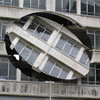Skip over navigation



Or search by topic
Number and algebra
Geometry and measure
Probability and statistics
Working mathematically
Advanced mathematics
For younger learners
Drawing Celtic Knots
Age 11 to 14
Challenge Level 





- Problem
- Getting Started
- Student Solutions
- Teachers' Resources
Start with smaller grids.
Start by shading where the "ribbons" will go, and then draw in the knot systematically by drawing an over and under sequence.
Start by shading where the "ribbons" will go, and then draw in the knot systematically by drawing an over and under sequence.
Related Collections
You may also like
More on Mazes
There is a long tradition of creating mazes throughout history and across the world. This article gives details of mazes you can visit and those that you can tackle on paper.
Mathematical Patchwork
Jenny Murray describes the mathematical processes behind making patchwork in this article for students.
Turning the Place Over
As part of Liverpool08 European Capital of Culture there were a huge number of events and displays. One of the art installations was called "Turning the Place Over". Can you find our how it works?

